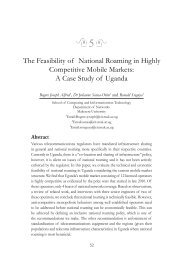Undergraduate Handbook - School of Computing and Informatics ...
Undergraduate Handbook - School of Computing and Informatics ...
Undergraduate Handbook - School of Computing and Informatics ...
Create successful ePaper yourself
Turn your PDF publications into a flip-book with our unique Google optimized e-Paper software.
Course Description: The course aims to provide students with the skills required to design, implement <strong>and</strong> evaluate<br />
robust ecommerce applications. The theory <strong>and</strong> application <strong>of</strong> electronic commerce solutions on the internet to<br />
improve business pr<strong>of</strong>it are presented. The techniques, tools <strong>and</strong> infrastructure required for on-line transactions are<br />
presented. The course includes a major group project, which draws on a wide range <strong>of</strong> skills <strong>of</strong> team members to set<br />
up an integrated electronic business. Issues such as business-to-business transactions are also covered.<br />
Indicative Content: Computerized trading systems, electronic funds transfer, automatic product identification <strong>and</strong><br />
bar code technology, electronic data interchange; the infrastructure <strong>of</strong> electronic commerce; electronic payment<br />
systems; Electronic commerce retailing <strong>and</strong> corporate finance; Intranets <strong>and</strong> supply chain management; remote<br />
banking, procurement <strong>and</strong> purchasing, online marketing <strong>and</strong> advertisement, home shopping, <strong>and</strong> auctions.<br />
Ecommerce security issues, transaction integrity <strong>and</strong> electronic payment systems are considered; <strong>and</strong> legal aspects <strong>of</strong><br />
ecommerce.<br />
Reference Books:<br />
i. J. F. Rayport <strong>and</strong> G. J. Jaworski, Introduction to e-Commerce, McGraw-Hill, 2002.<br />
ii. J. F. Rayport <strong>and</strong> G. J. Jaworski,. Cases in e-Commerce, McGraw-Hill, 2002.<br />
iii. E. Turban, et al., Electronic Commerce, a Managerial Perspective, Upper Saddle River, NJ; Pearson<br />
Prentice Hall, 2004.<br />
iv. G. P. Schneider, Electronic Commerce: The Second Wave, Boston MA Thompson Course Technology,<br />
2004.<br />
BIT 2105 Electronic Media Systems <strong>and</strong> Multimedia (3 CU)<br />
Course Description: This course provides a comprehensive overview <strong>of</strong> the various platforms, applications, media<br />
<strong>and</strong> technology used to develop digital media products <strong>and</strong> communications. This course will investigate the use <strong>of</strong><br />
several s<strong>of</strong>tware tools for multimedia production <strong>and</strong> the ways in which media components can be represented <strong>and</strong><br />
integrated into final multimedia production. The course aims at:- Introducing students to the concepts <strong>of</strong> electronic<br />
media, the systems there <strong>of</strong> <strong>and</strong> the general field <strong>of</strong> multimedia.<br />
Indicative Content: Introduction to digital graphics, photography, video, audio, networked multimedia <strong>and</strong><br />
authoring; Visual design skills: leading to Graphic Design <strong>and</strong> other major areas <strong>of</strong> Multimedia Production,<br />
including a variety <strong>of</strong> design techniques using specialist s<strong>of</strong>tware to design <strong>and</strong> manipulate images.<br />
Reference Books:<br />
i. R. Steinmetz <strong>and</strong> K. Nahrstedt, Multimedia Systems, Springer 2004.<br />
ii. Z- Nian Li <strong>and</strong> M. S. Drew, Fundamentals <strong>of</strong> Multimedia, Prentice Hall 2003.<br />
iii. R. Steinmetz <strong>and</strong> K. Nahrstedt, Multimedia Applications, Springer 2004.<br />
BIT 2107 Web Systems <strong>and</strong> Technologies I (3 CU)<br />
Course Description: This course aims to: Provide an underst<strong>and</strong>ing <strong>of</strong> the basics <strong>of</strong> the Internet, how it originated,<br />
how it works, <strong>and</strong> how to develop <strong>and</strong> maintain Web sites; Provide a basic underst<strong>and</strong>ing <strong>of</strong> Internet related<br />
technologies <strong>and</strong> introductory skills in Web applications. On completion <strong>of</strong> this course unit, the students will be able<br />
to: Have essential skills for website management; demonstrate underst<strong>and</strong>ing <strong>of</strong> the basic Internet technology<br />
concepts <strong>and</strong>; Develop a prototype <strong>of</strong> interactive World Wide Web applications.<br />
Indicative Content: HTML editors; website management tools such as FrontPage <strong>and</strong>/or Dream weaver; Basic<br />
Internet technologies such as DNS, email services, LDAP <strong>and</strong> the HTTP protocol; Introduction to tools <strong>and</strong><br />
techniques for specifying <strong>and</strong> prototyping interactive World Wide Web applications based on HTML. Web<br />
technologies: HTTP Protocol, Presentation abstractions, Web-markup <strong>and</strong> display languages.<br />
Reference Books:<br />
73

















